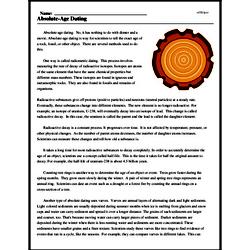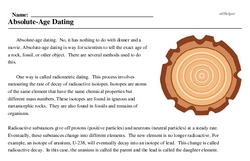Absolute-Age Dating
Absolute-age dating. No, it has nothing to do with dinner and a movie. Absolute-age dating is way for scientists to tell the exact age of a rock, fossil, or other object. There are several methods used to do this.
One way is called radiometric dating. This process involves measuring the rate of decay of radioactive isotopes. Isotopes are atoms of the same element that have the same chemical properties but different mass numbers. These isotopes are found in igneous and metamorphic rocks. They are also found in fossils and remains of organisms.
Radioactive substances give off protons (positive particles) and neutrons (neutral particles) at a steady rate. Eventually, these substances change into different elements. The new element is no longer radioactive. For example, an isotope of uranium, U-238, will eventually decay into an isotope of lead. This change is called radioactive decay. In this case, the uranium is called the parent and the lead is called the daughter element.




